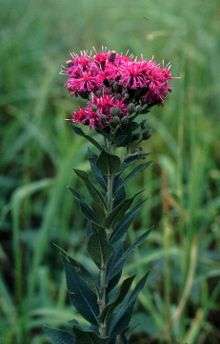Vernonia
| Vernonia | |
|---|---|
 | |
| Vernonia baldwinii | |
| Scientific classification | |
| Kingdom: | Plantae |
| (unranked): | Angiosperms |
| (unranked): | Eudicots |
| (unranked): | Asterids |
| Order: | Asterales |
| Family: | Asteraceae |
| Tribe: | Vernonieae |
| Genus: | Vernonia Schreb. |
| Synonyms[1] | |
| |
Vernonia is a genus of about 1000 species of forbs and shrubs in the family Asteraceae. Some species are known as ironweed. Some species are edible and of economic value. They are known for having intense purple flowers. The genus is named for the English botanist William Vernon. There are numerous distinct subgenera and subsections in this genus. This has led some botanists to divide this large genus into several distinct genera.[2] For instance, the Flora of North America only recognizes about 20 species in Vernonia sensu stricto, 17 of which are in North America north of Mexico, with the others being found in South America.[3]
Uses
_W2_IMG_2850.jpg)
Several species of Vernonia, including V. calvoana, V. amygdalina, and V. colorata, are eaten as leaf vegetables. Common names for these species include bitterleaf, ewuro, ndole and onugbu. They are common in most West African and Central African countries. They are one of the most widely consumed leaf vegetables of Cameroon, where they are a key ingredient of Ndolé. The leaves have a sweet and bitter taste. They are sold fresh or dried, and are a typical ingredient in egusi soup.
Vernonia amygdalina is well known as a medicinal plant with several uses attributed to it, including for diabetes, fever reduction, and recently a non-pharmaceutical solution to persistent fever, headache, and joint pain associated with AIDS (an infusion of the plant is taken as needed).[4][5] These leaves are exported from several African countries and can be purchased in grocery stores aiming to serve African clients. The roots of V. amygdalina have been used for gingivitis and toothache due to its proven antimicrobial activity.[6]
In Brazil, V. condensata (commonly known as "figatil" or "necroton") is traditionally used as an analgesic, anti-inflammatory, antithermal, antianemic, antibacterial, liver tonic, hepatoprotective, and antiulcerogenic agent.[7]
Vernonia galamensis is used as an oilseed in East Africa. It is grown in many parts of Ethiopia, especially around the city of Harar, with an average seed yield of 2 to 2.5 t/ha. It is reported that the Ethiopian strains of Vernonia have the highest oil content, up to 41.9% with up to 80% vernolic acid, and is used in paint formulations, coatings plasticizers, and as a reagent for many industrial chemicals.[8]
Vernonia species are used as food plants by the larvae of some Lepidoptera species including Coleophora vernoniaeella (which feeds exclusively on the genus) and Schinia regia (which feeds exclusively on V. texana).
Vernonia calvoana or bitterleaf, is a common garden plant in many West African and Central African countries. It is a key ingredient in ndolé, a national dish of Cameroon.[9]
Species
_on_a_Ash_Fleabane_or_Little_ironweed_(Vernonia_cinerea)_in_Kolkata_W_IMG_3668.jpg)

Species of this genus are found in South America, Africa, Southeast Asia, and North America. Vernonia species are well known for hybridizing between similar species in areas of overlapping ranges. There are approximately 1000 species of Vernonia. A partial species list is given below.
North America
- Vernonia acaulis
- Vernonia arkansana
- Vernonia angustifolia
- Vernonia baldwinii
- Vernonia blodgettii
- Vernonia fasciculata
- Vernonia flaccidifolia
- Vernonia gigantea or Vernonia altissima[10]
- Vernonia glauca
- Vernonia larseniae
- Vernonia lettermannii
- Vernonia lindheimeri
- Vernonia marginata
- Vernonia missurica
- Vernonia noveboracensis
- Vernonia proctorii
- Vernonia pulchella
- Vernonia texana
South America
- Vernonia nonoensis
- Vernonia patens
- Vernonia scorpioides
- Vernonia condensata
Africa
- Vernonia amygdalina
- Vernonia bamendae
- Vernonia calvoana
- Vernonia colorata
- Vernonia galamensis
- Vernonia staehelinoides
Asia
- Vernonia arborea
- Vernonia cockburniana
- Vernonia elaeagnifolia
- Vernonia unicata
- Vernonia zollingerianoides
See also
References
- ↑ Flann, C (ed) 2009+ Global Compositae Checklist
- ↑ Harold Robinson (1999). "Generic and Subtribal Classification of American Vernonieae" (PDF). Smithsonian Contributions to Botany 89. Retrieved 17 September 2014.
- ↑ Flora of North America: Vernonia
- ↑ Herbal medicine--its use in treating some symptoms of AIDS; 9th International AIDS Conference
- ↑ Report:INDIGENOUS APPROACHES TO THE HIV/AIDS SCOURGE IN UGANDA, Chap. 5
- ↑ TRADITIONAL MEDICINE DEVELOPMENT FOR MEDICAL AND DENTAL PRIMARY HEALTH CARE DELIVERY SYSTEM IN AFRICA. African Journal of Traditional, Complementary and Alternative Medicines. Vol. 2, Num. 1, 2005, pp. 46-61
- ↑ Jucélia Barbosa da Silva, Vanessa dos Santos Temponi, Carolina Miranda Gasparetto; et al. (2013). "Vernonia condensata Baker (Asteraceae): A Promising Source of Antioxidants". Oxidative Medicine and Cellular Longevity. Article ID 698018. doi:10.1155/2013/698018.
- ↑ "Alamata Pilot Learning Site Diagnosis and Program Design" IPMS Information Resources Portal - Ethiopia (23 June 2005), p. 12 (accessed 3 March 2009)
- ↑ Veronia calvoana, Plant Encyclopedia
- ↑ Flora of North America: Vernonia gigantea
External links
| Wikimedia Commons has media related to Vernonia. |
| Wikispecies has information related to: Vernonia |
- "Vernonia Information System". Arid Land Agricultural Research Center. Retrieved 2006-09-10.
- "Crop fact sheet for V. galamensis". Purdue University Center for New Crops and Plant Products. Retrieved 2006-09-10.
- Multilingual taxonomic information from the University of Melbourne
- "Effect of Processing and Preservation Methods on Vitamin C and Total Carotenoid Levels of some Vernonia (Bitter Leaf) Species". Retrieved 2006-09-10.